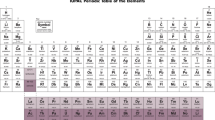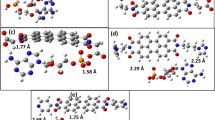Abstract
2,4,6-triaryloxy-1,3,5-triazines (POT) form in general molecular diads, termed as Piedfort Units (PU), in their crystals and their clathrates. Their bulky phenyl substituents (R = Me, F, Cl, Br, I, CN) in ortho, meta or para position substantially hinder internal rotations. Instead, non-crystallographic rotations (ncr) or translations (nct) are the bridges between the semirigid homologues or analogues, occasionally polymorphs. They occur in the space groups R3c (161), \(R\bar 3\) (148), \(P\bar 3c1\) (165), P63/m (176), \(P\bar 31c\) (163), P21/c (14), Ia (9), and \(P\bar 1\) (2). In each group, the molecules are close to be isometrical, while these groups are linked by non-crystallographic symmetries termed morphotropism. The observed non-crystallographic symmetries are virtual between the homologues and real between their dimorphs. Real ncr’s were also found between 4-RPOTs and their clathrate forms. It is demonstrated how e.g. toluene induces real nrc’s in its clathrate with 4-IPOT.












Similar content being viewed by others
Notes
“Because evidently impossible to define isomorphism precisely, we shall apply the term isostuctural to crystals in which there is essentially the same arrangement of geometrically similar structural units. Although it is not more precise than isomorphous this term refers to the general nature of the structure rather than the shape of the crystals.”
References
Kálmán A, Párkányi L, Argay G (1993) Acta Crystallogr B 49:1039–1049
Wells AF (1960) Inorganic structural chemistry, 3rd edn. Clarendon, Oxford 186
Ojala WH, Smieja JM, Spude JM, Arola TM, Kupsa MK, Herrera N, Ojala CR (2007) Acta Crystallogr B 63:485–496
Saha BK, Nangia A (2007) Cryst Growth Des 7:396–401
Fábián L, Kálmán A (1999) Acta Crystallogr B 55:1099–1108
Rutherford JS (1997) Acta Chim Hung 134:395–405
Dziubek KF, Katrusiak A (2003) Z Kristallogr 218:1–8
Gelbrich T, Hursthouse MB (2005) CrystEngComm 7:324–336 (and references therein)
Hundt R, Schön JC, Jansen MJ (2006) J Appl Crystallogr 39:6–16
Kálmán A, Párkányi L (1997) In: Hargittai M, Hargittai I (eds) Advances in molecular structure research, vol 3. JAI Press, Greenwich, pp 189–226
Kálmán A (2005) Acta Crystallogr B 61:536–547
Kálmán A, Fábián L (2007) Acta Crystallogr B 63:411–417
Groth P (1870) Berichte Chem Ges 3:449–457
Groth P (1906) An introduction to chemical crystallography (trans. H. Marschall) Gurney & Jackson, London, pp 36–65
Kitaigorodskii AI (1961) Organic chemical crystallography. Consultants Bureau, New York
Fábián L, Kálmán A, Argay G, Bernáth G, Gyarmati ZC (2005) Cryst Growth Des 5:773–782
Fábián L, Kálmán A, Argay G, Bernáth G, Gyarmati ZC (2004) Chem Commun pp 2114–2115
Fábián L, Bombicz P, Czugler M, Kálmán A, Weber E, Hecker M (1999) Supramol Chem 11:151–167
Zimmermann H, Bürzlaff H (1985) Z Kristall 170:241–246
Anthony AR, Desiraju GR, Jetti RKR, Kuduva SS, Madhavi NNL, Nangia A, Thaimattam R, Thalladi VR (1998) Cryst Eng 1:1–18
Thalladi VR, Brasselet S, Weiss HC, Bläser D, Katz AK, Carrell HL, Boese R, Zyss J, Nangia A, Desiraju GR (1998) J Am Chem Soc 120:2563–2577
Boese R, Desiraju GR, Jetti RKR, Kirchner MT, Ledoux I, Thalladi VR, Zyss J (2002) Struct Chem 13:321–328
Reichenbächer K, Süss HI, Stoeckli-Evans H, Bracco S, Sozzani P, Weber E, Hulliger J (2004) New J Chem 28:393–397
Saha BK, Aitipamula S, Banerjee R, Nangia A, Jetti RKR, Boese R, Lam CK, Mak TC (2005) Mol Cryst Liq Cryst 440:295–316
Saha BK, Nangia A (2007) Heteroat Chem 18:185–194
Bombicz P, Kálmán A (2008) Cryst Growth Des 8:2821–2823
Allen FH (2002) Acta Crystallogr B 58:380–388
Jessiman AS, MacNicol DD, Malison PR, Wallace IJ (1990) Chem Soc Chem Commun, pp 1619–1621
Fábián L, Kálmán A (2004) Acta Crystallogr B 60:547–558
Báthori NB (2006) PhD thesis, Budapest (paper on synthesis is in preparation)
Acknowledgments
The authors thank Professors László Bihátsi and Mátyás Czugler for their valuable advices to the PhD work of N. B. Báthori (Budapest). P. B. and A. K. acknowledge the support from the Hungarian Scientific Research Foundation (OTKA K-100801).
Author information
Authors and Affiliations
Corresponding author
Additional information
Dedicated to Professor Magdolna Hargittai on the occasion of her 70th birthday.
Appendix
Appendix
Graphic abbreviations:
-
POT⊥C 3 Perpendicular to the C 3 axis of the POT molecule
-
POT∥C 3 Parallel to the C 3 axis of the POT molecule
Crystal data and details of structure determination and refinement of 4-IPOT, 4-IPOT_TOL, 4-iPrPOT and 2-MePOT:
4-IPOT [30]
Crystal data: (2,4,6-tris(4-iodophenoxy)-1,3,5-triazine (C21H12I3N3O3, Ms = 735.04, trigonal R3c (No. 161) a = b = 24.831(5), c = 6.627(1) Å, α = β = 90°, γ = 120°, V = 3538.7(1) Å3, Z = 6, Dc (g cm−3) = 2.069, μ (mm−1) = 4.00 (size 0.14 × 0.02 × 0.02 mm), colourless needles from acetonitrile.
X-ray data: R-Axis Rapid, 93(2)K, λ(MoKα) = 0.71070 Å, θ = 3.28–23.24°, N tot = 30080 Nobs = 1064/91, [I > 2σI] = 968, R m = 0.104 (abs. num.c.) Max/min trans 0.9243/0.6043. R 1, wR 2 [I > 2σI] = 0.0391, 0.0604, R 1, wR 2 (total) = 0.0445, 0.0620, [e Å−3] −0.27/0.294
4-IPOT_TOL [30]
Crystal data: (2,4,6-tris(4-iodolphenoxy)-1,3,5-triazine·toluene clathrate (C21H12N3O3I3·C7H8), Ms = 827.19, trigonal \(R\bar 3\) (No. 148) a = b = 15.592(1), c = 18.359(2) Å, α = β = 90°, γ = 120°, V = 3865.3 (7) Å3, Z = 6, Dc (g cm−3) = 2.189, μ (mm−1) = 28.824 (size 0.50 × 0.30 × 0.30 mm) colourless prisms from toluene.
X-ray data: R-Axis Rapid, 98(2)K, λ(CuKα) = 1.5418 Å, θ = 0.9–73.2.0°, N tot = 17538, Nobs = 1655/198, [I > 2σI] = 1285, R m = 0.338 (abs. cylinder), Max/min trans 0.0006/0.0271. R 1, wR 2 [I > 2σI] = 0.1264/0.3056, R 1, wR 2 (total) = 0.1373/0.3246, [e Å−3] −3.347/3.349.
4-iPrPOT [30]
Crystal data: (2,4,6-tris(4-isopropylphenoxy)-1,3,5-triazine (C30H33N3O3, Ms = 483.59, trigonal R3c (No. 161) a = b = 24.259(1), c = 7.805(1) Å, α = β = 90°, γ = 120°, V = 3977.9 (6) Å3, Z = 6, Dc (g cm−3) = 1.211, μ (mm−1) = 0.101 (size 0.40 × 0.30 × 0.06 mm) colourless prisms from dichloromethane.
X-ray data: R-Axis Rapid, 99(2)K, λ(MoKα) = 0.71070 Å, θ = 3.34–27.32° N tot = 19346 Nobs = 2030/123, [I > 2σI] = 1413, R m = 0.163 (abs. num.c.) Max/min trans 0.9961/0.9961. R 1, wR 2 [I > 2σI] = 0.0708, 0.1149, R 1, wR 2 (total) = 0.1090, 0.1320, [e Å−3] −0.214/0.231
2-MePOT [30]
Crystal data: (2,4,6-tris(2-methylphenoxy)-1,3,5-triazine (C24H21N3O, Ms = 399.44, trigonal R3c (No. 161) a = b = 20.593(1), c = 8.605(1) Å α = β = 90°, γ = 120°, V = 3160.6 (5) Å3, Z = 6, Dc (g cm−3) = 1.259, μ (mm−1) = 0.684 (size 0.11 × 0.15 × 0.29 mm) colourless prisms from toluene.
X-ray data: R-Axis Rapid, 173(2)K, λ(CuKα) = 1.5418 Å, θ = 7.45–71.78° N tot = 14029, Nobs = 1355/92, [I > 2σI] = 890, R m = 0.140 (abs. num.c.) Max/min trans 0.9286/0.8263, R 1, wR 2 [I > 2σI] = 0.0447/0.1017, R 1, wR 2 (total) = 0.0592/0.1063, [e Å−3] −0.09/0.08
Rights and permissions
About this article
Cite this article
Bombicz, P., Báthori, N.B. & Kálmán, A. Symmetry-controlled rearrangements in Piedfort Units (PU) of 2,4,6-triaryloxy-1,3,5-triazines. Struct Chem 26, 1611–1619 (2015). https://doi.org/10.1007/s11224-015-0659-8
Received:
Accepted:
Published:
Issue Date:
DOI: https://doi.org/10.1007/s11224-015-0659-8




